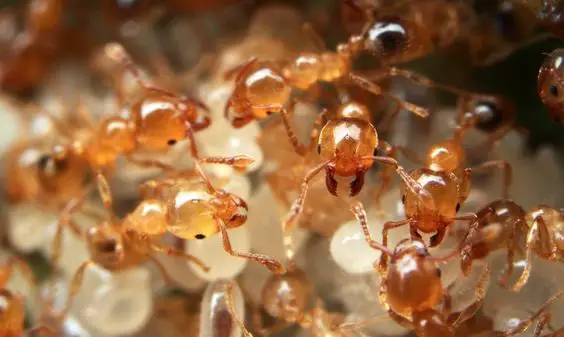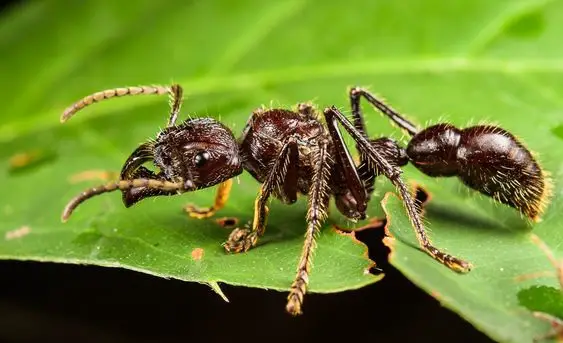Have you ever stopped to think about all the ants in Utah? There are over 180 species of ants found in Utah, and they play an important role in the state’s ecosystem.
From the deserts of southern Utah to the mountains of the north, ants play an important role in the state’s ecosystem.
Ants are social insects, and they live in colonies that can range in size from a few dozen individuals to millions. Each colony has a queen, who is responsible for laying eggs. The worker ants are responsible for gathering food, building the nest, and caring for the young.
They play an important role in the food chain by helping to control populations of other insects. Ants also help to aerate the soil and disperse seeds.
Types Of Ants in Utah
Ants are one of the most common and successful insects on the planet, and Utah is no exception. Some of the common types of ants in Utah include:
Carpenter ants

Carpenter ants are one of the largest ant species in Utah.
- Size and Color: They can grow up to an inch long and come in a variety of shades, from black to reddish-brown. Some species have a subtle striped pattern on their abdomen.
- Habitat: Carpenter ants are found throughout Utah, from the deserts to the mountains. They prefer to nest in damp, decaying wood, so they are often found in old tree stumps, fallen logs, or even inside homes.
- Biodiversity: There are over 25 species of carpenter ants in Utah. Some of the most common species include:
- Camponotus herculeanus
- Camponotus modoc
- Complications and Impact: Carpenter ants can cause a number of problems for homeowners and businesses. They can damage wood structures by tunneling through them and spread diseases, such as salmonella and dysentery.
Harvester Ants in Utah

Utah’s arid landscapes are home to a diverse array of fascinating insects; among them, you’ll find the industrious harvester ants.
- Size and Color: Harvester ants are medium-sized ants, typically ranging from 1/5 to 1/2 inch in length. They are usually reddish-brown to black in color. Some species may have a slightly metallic sheen.
- Habitat: Harvester ants are found throughout Utah, primarily in arid and semi-arid regions. They prefer to nest in open areas with sandy or gravelly soil, often creating large, mound-shaped nests
- Biodiversity: There are over 20 species of harvester ants in Utah. Some of the most common species include:
- Pogonomyrmex barbatus (Red Harvester Ant)
- Pogonomyrmex occidentalis (Western Harvester Ant)
- Complications and Impact: Harvester ants can cause a number of problems for homeowners and gardeners. They can damage lawns and gardens by stripping plants of their seeds and leaves and create unsightly mounds in yards and gardens.
Pavement Ants in Utah

Pavement ants are one of the most common household pests in Utah, particularly in urban and suburban areas.
- Size & Color: Pavement ants are small ants, typically ranging from 1/8 to 1/4 inch in length. They are usually black or brown in color.
- Habitat: Pavement ants are found throughout Utah, primarily in urban and suburban areas. They prefer to nest in cracks and crevices in pavement, sidewalks, and foundations. They are also found nesting in soil, under mulch, and around potted plants.
- Biodiversity: There is only one species of pavement ant in Utah: Tetramorium immigrants.
- Complications and Impact: Pavement ants can cause a number of problems for homeowners and businesses. They can infest homes and businesses, foraging for food and crumbs.
Pharaoh ants

Those tiny little ants you keep seeing in your kitchen? They’re probably pharaoh ants, and they’re one of the most common pests in Utah homes.
- Size and Color: Pharaoh ants are small, measuring about 1/16 to 1/12 inch in length. They are light yellow to reddish-brown in color, with darker markings on their abdomen. Only the queen and males have wings.
- Habitat: Pharaoh ants are native to tropical regions but have become an invasive species in many parts of the world, including Utah. They prefer to nest in warm, humid environments, such as kitchens, bathrooms, and electrical outlets. They can also be found nesting in outdoor areas, such as under mulch, in potted plants, and in cracks and crevices.
- Biodiversity: There is only one species of pharaoh ant: Monomorium pharaonis.
- Complications: Pharaoh ants are a major nuisance pest. They can infest homes and businesses, foraging for food and crumbs. They spread diseases, such as salmonella and dysentery. Pharaoh ants bite and cause pain and irritation.
- Impact: Pharaoh ants can have a number of negative impacts on the environment, agriculture, and human health. They can damage crops and trees by feeding on their leaves and fruits.
Thief ants

Thief ants are tiny ants that love to party in your Utah home. Moreover, they are light brown to almost black and about the size of a pencil tip.
- Size and Color: Thief ants are small, measuring about 1/16 inch in length. They are pale yellow to brown in color.
- Habitat: Thief ants are found throughout Utah, primarily in urban and suburban areas. They prefer to nest in moist, protected locations, such as under stones, in leaf litter, and in rotting wood.
- Biodiversity: There are over 100 species of thief ants worldwide, but only a few are found in Utah. Some of the most common species include: Solenopsis molesta (Common Thief Ant) and Solenopsis molesta (Richmond Thief Ant)
- Complications: Thief ants can be a nuisance pest in homes and businesses. They can contaminate food with their droppings or saliva; furthermore, they can also bite and sting, causing pain and irritation.
- Impact: They can contaminate food with their droppings or saliva; furthermore, they can also bite and sting, causing pain and irritation.
Conclusion
Ants are a common and important part of the Utah environment. Additionally, by understanding the different types of ants that are common in Utah, you can take steps to prevent them from becoming a problem.
While there are various methods to control ants when they invade your home or yard, it’s crucial to remember that they play a vital role in the environment and should not be eradicated indiscriminately.



